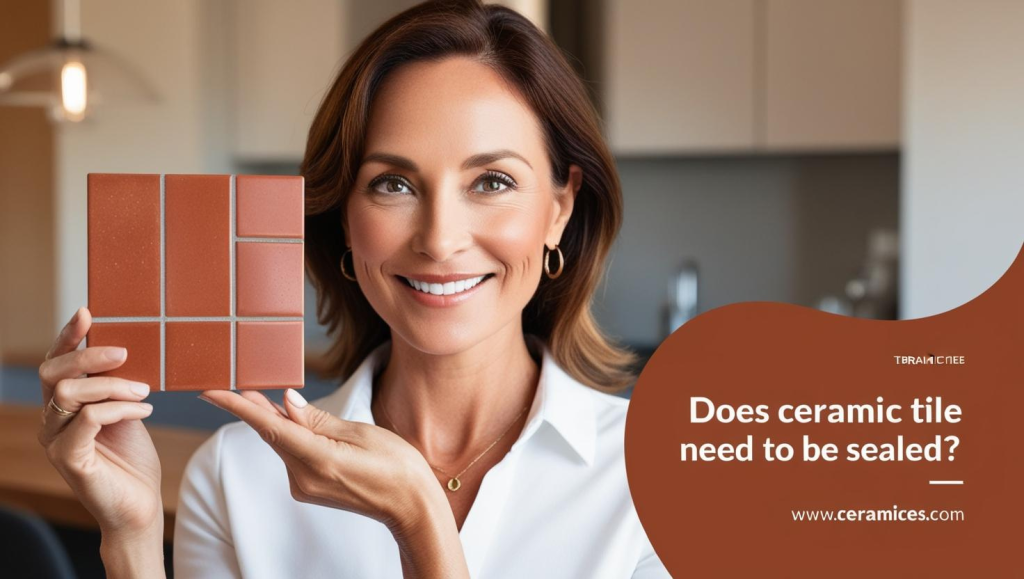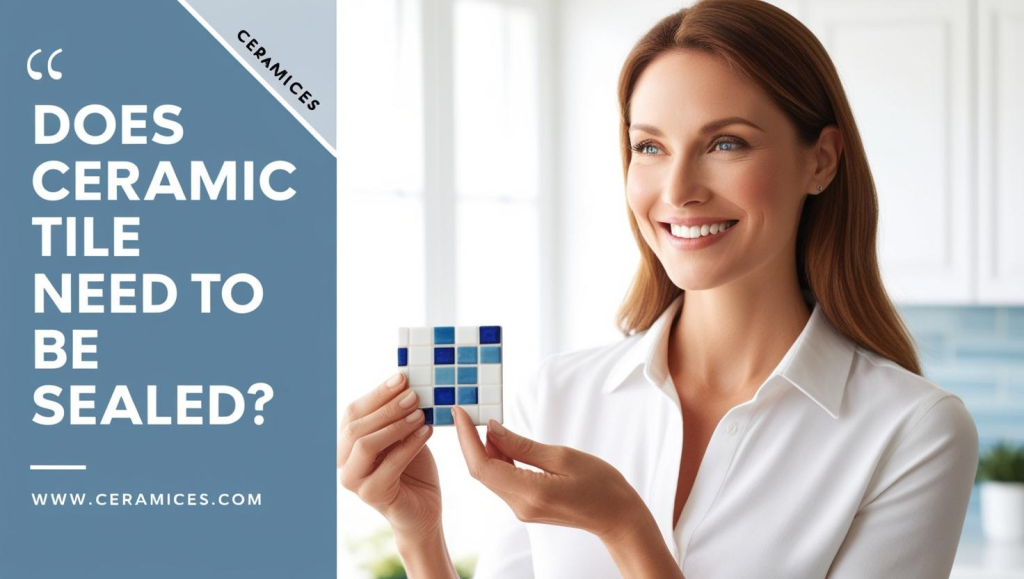Ceramic tiles are a popular choice for floors, walls, and countertops due to their durability, versatility, and aesthetic appeal. They are commonly used in kitchens, bathrooms, and other high-traffic areas because of their resistance to moisture and stains. However, one question that often arises among homeowners and DIY enthusiasts is, “Does ceramic tile need to be sealed?” The answer depends on the type of ceramic tile, its glaze, and the area where it’s installed. In this comprehensive guide, we’ll explore whether ceramic tiles need sealing, the benefits of sealing, and how to properly seal ceramic tiles. We’ll also answer 10 frequently asked questions to help you make informed decisions about maintaining your ceramic tiles.
Understanding Ceramic Tiles: Composition and Properties
Before diving into whether ceramic tiles need to be sealed, it’s essential to understand what ceramic tiles are made of and how they are designed. Ceramic tiles are made from clay that is shaped, glazed, and fired at high temperatures. This process creates a hard, durable surface that is resistant to water and stains. However, the properties of ceramic tiles can vary depending on their type and finish.
Key Characteristics of Ceramic Tiles:
- Glazed vs. Unglazed: Glazed tiles have a protective layer that makes them non-porous, while unglazed tiles are more porous.
- Durability: Ceramic tiles are hard and resistant to wear and tear.
- Water Resistance: Glazed tiles are naturally water-resistant, but unglazed tiles can absorb water and stains.
Does Ceramic Tile Need to Be Sealed? The Answer Explained

The short answer is it depends. Whether ceramic tiles need to be sealed depends on their type, finish, and the area where they are installed. Here’s a breakdown:
Glazed Ceramic Tiles:
- Do Not Need Sealing: Glazed ceramic tiles have a protective layer that makes them non-porous and resistant to water and stains. Sealing is generally not required.
- Exception: The grout between glazed tiles may need sealing, as it is porous and can absorb water and stains.
Unglazed Ceramic Tiles:
- Need Sealing: Unglazed ceramic tiles are porous and can absorb water, stains, and dirt. Sealing is recommended to protect the tiles and maintain their appearance.
Factors to Consider:
- Tile Type: Determine whether your tiles are glazed or unglazed.
- Installation Area: Tiles in high-moisture areas like bathrooms and kitchens may benefit from sealing, especially the grout.
- Traffic Level: High-traffic areas may require more frequent sealing to maintain durability.
Benefits of Sealing Ceramic Tiles
Sealing ceramic tiles, especially unglazed tiles and grout, offers several advantages:
- Stain Resistance: Sealing prevents stains from penetrating the tile or grout.
- Water Resistance: Sealing protects tiles and grout from water damage, which is especially important in wet areas.
- Easier Cleaning: Sealed tiles and grout are easier to clean and maintain.
- Longevity: Sealing extends the lifespan of tiles and grout by protecting them from wear and tear.
How to Seal Ceramic Tiles
If you determine that your ceramic tiles or grout need sealing, follow these steps for a professional finish:
Step 1: Clean the Tiles
Thoroughly clean the tiles and grout with a pH-neutral cleaner to remove dirt, grease, and residue. Allow the surface to dry completely.
Step 2: Choose the Right Sealer
Select a sealer appropriate for your tiles and grout. Penetrating sealers are ideal for unglazed tiles, while topical sealers work well for grout.
Step 3: Apply the Sealer
Using a brush, roller, or spray bottle, apply the sealer evenly to the tiles or grout. Follow the manufacturer’s instructions for application and drying times.
Step 4: Wipe Off Excess Sealer
After the sealer has penetrated the surface, wipe off any excess with a clean cloth to avoid a sticky residue.
Step 5: Allow to Cure
Let the sealer cure completely before using the tiled area. This can take anywhere from a few hours to a few days, depending on the product.
Types of Tile Sealers
There are several types of sealers available for ceramic tiles and grout:
1. Penetrating Sealers
- Absorb into the tile or grout to provide protection from within.
- Ideal for unglazed tiles and natural stone.
- Does not alter the appearance of the tile.
2. Topical Sealers
- Form a protective layer on the surface of the tile or grout.
- Ideal for grout and high-traffic areas.
- Can enhance the color and shine of the tile.
3. Impregnating Sealers
- Combine the benefits of penetrating and topical sealers.
- Provide deep protection while also creating a surface barrier.
When to Seal Ceramic Tiles

Knowing when to seal your ceramic tiles is just as important as knowing how. Here are some guidelines:
- After Installation: Seal unglazed tiles and grout immediately after installation.
- Regular Maintenance: Reapply sealer every 1–3 years, depending on traffic and wear.
- Before Staining Occurs: Seal tiles and grout in high-risk areas like kitchens and bathrooms to prevent stains.
Risks of Not Sealing Ceramic Tiles
Failing to seal unglazed tiles or grout can lead to several issues:
- Stains: Porous tiles and grout can absorb spills, leading to permanent stains.
- Water Damage: Unsealed tiles and grout can absorb water, causing mold and mildew growth.
- Wear and Tear: Unprotected tiles and grout are more prone to cracking and deterioration.
Tips for Maintaining Sealed Ceramic Tiles
To keep your sealed ceramic tiles looking their best, follow these tips:
- Clean Regularly: Use a pH-neutral cleaner to avoid damaging the sealer.
- Avoid Harsh Chemicals: Abrasive cleaners can strip the sealer and damage the tiles.
- Reapply Sealer as Needed: Monitor the condition of the tiles and grout and reapply sealer when necessary.
FAQs About Sealing Ceramic Tiles
1. Do all ceramic tiles need to be sealed?
No, only unglazed ceramic tiles and grout typically need to be sealed. Glazed tiles are naturally resistant to water and stains.
2. How often should I seal my ceramic tiles?
Unglazed tiles and grout should be sealed every 1–3 years, depending on usage and wear.
3. Can I seal glazed ceramic tiles?
Sealing glazed tiles is generally unnecessary, but the grout between them may benefit from sealing.
4. What happens if I don’t seal unglazed tiles?
Unglazed tiles can absorb water, stains, and dirt, leading to damage and discoloration.
5. Can I use the same sealer for tiles and grout?
Yes, but make sure the sealer is suitable for both materials. Some sealers are specifically designed for grout.
6. How do I know if my tiles need resealing?
Perform a water test: sprinkle water on the tiles or grout. If it beads up, the sealer is still effective. If it absorbs, it’s time to reseal.
7. Can I seal ceramic tiles myself?
Yes, sealing ceramic tiles is a DIY-friendly project if you follow the proper steps and use the right products.
8. How long does tile sealer take to dry?
Drying times vary by product but typically range from a few hours to a full day.
9. Is sealing ceramic tiles expensive?
The cost of sealing ceramic tiles is relatively low compared to the benefits of protection and longevity.
10. Can I walk on sealed tiles immediately?
Wait until the sealer has fully cured before walking on the tiles or using the area.
Conclusion
So, does ceramic tile need to be sealed? The answer depends on the type of tile and its application. While glazed ceramic tiles do not require sealing, unglazed tiles and grout benefit significantly from the added protection. Sealing prevents stains, water damage, and wear, ensuring your tiles remain beautiful and functional for years to come.
By understanding the properties of ceramic tiles and following the tips and guidelines outlined in this article, you can make informed decisions about sealing and maintaining your tiled surfaces. Whether you’re installing new tiles or refreshing an existing space, proper sealing is a simple yet effective way to protect your investment and keep your tiles looking their best. Happy tiling!
Read more articles